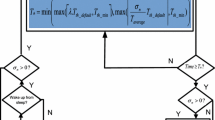Abstract
In this paper, we evaluate the performance of the IEEE 802.16e sleep mode mechanism in wireless access networks. This mechanism reduces the energy consumption of a mobile station (MS) by allowing it to turn off its radio interface (sleep mode) when there is no traffic present at its serving base station (BS). After a sleep period expires, the MS briefly checks the BS for data packets and switches off for the duration of another sleep period if none are available. Specifically for IEEE 802.16e, each additional sleep period doubles in length, up to a certain maximum. Clearly, the sleep mode mechanism can extend the battery life of the MS considerably, but also increases the delay at the BS buffer. For the performance analysis, we use a discrete-time queueing model with general service times and multiple server vacations. The vacations represent the sleep periods and have a length depending on the number of preceding vacations. Unlike previous studies, we take the (short-range) traffic correlation into account by assuming a D-BMAP arrival process, i.e. the distribution of the number of packet arrivals per slot is modulated by the transitions in a Markov chain with N background states. As results, we obtain the distribution of the number of packets in the queue at various sets of time epochs, the distribution of the packet delay and the antenna activity rate. We apply these results to the IEEE 802.16e sleep mode mechanism with correlated downlink traffic. By means of some examples, we show the influence of both the configuration parameters and the traffic correlation on the delay and the energy consumption.
Similar content being viewed by others
References
IEEE 802.16e-2005, Part 16: Air interface for fixed and mobile broadband wireless access systems—Amendment 2: physical and medium access control layers for combined fixed and mobile operation in licensed bands—Corrigendum 1, February 2006.
Kuran, M. S., & Tugcu, T. (2007). A survey on emerging broadband wireless access technologies. Computer Networks, 51(11), 3013–3046.
Xiao, Y. (2005). Energy saving mechanism in the IEEE 802.16e wireless MAN. IEEE Communications Letters, 9(7), 595–597.
Zhang, Y., & Fujise, M. (2006). Energy management in the IEEE 802.16e MAC. IEEE Communications Letters, 10(4), 311–313.
Han, K., & Choi, S. (2006). Performance analysis of sleep mode operation in IEEE 802.16e mobile broadband wireless access systems. In Proceedings of the IEEE 63rd vehicular technology conference, VTC2006-Spring (Melbourne, 7–10 May 2006) (Vol. 3, pp. 1141–1145).
Park, Y., & Hwang, G. U. (2007). Performance modelling and analysis of the sleep-mode in IEEE 802.16e WMAN. In Proceedings of the IEEE 65th vehicular technology conference, VTC2007-Spring (Dublin, 22–25 April 2007) (pp. 2801–2806).
Seo, J.-B., Lee, S.-Q., Park, N.-H., Lee, H.-W., & Cho, C.-H. (2004). Performance analysis of sleep mode operation in IEEE 802.16e. In Proceedings of the 60th vehicular technology conference, VTC2004-Fall (Los Angeles, 26–29 September 2004) (Vol. 2, pp. 1169–1173).
Kwon, S.-J., Chung, Y. W., & Sung, D. K. (2003). Queueing model of sleep-mode operation in cellular digital packet data. IEEE Transactions on Vehicular Technology, 52(4), 1158–1162.
Lin, Y.-B., & Chuang, Y.-M. (1999). Modeling the sleep mode for cellular digital packet data. IEEE Communications Letters, 3(3), 63–65.
Lee, N.-H., & Bahk, S. (2005). MAC sleep mode control considering downlink traffic pattern and mobility. In Proceedings of the IEEE 61st vehicular technology conference, VTC2005-Spring (Stockholm, 30 May–1 June 2005) (Vol. 3, pp. 2076–2080).
Bruneel, H. (1988). Queueing behavior of statistical multiplexers with correlated inputs. IEEE Transactions on Communications, 36(12), 1339–1341.
Wittevrongel, S., & Bruneel, H. (1999). Discrete-time queues with correlated arrivals and constant service times. Computers & Operations Research, 26(2), 93–108.
Blondia, C., & Casals, O. (1992). Statistical multiplexing of VBR sources: A matrix-analytic approach. Performance Evaluation, 16(1–3), 5–20.
Andersen, A. T., & Nielsen, B. F. (1998). A Markovian approach for modeling packet traffic with long-range dependence. IEEE Journal on Selected Areas in Communications, 16(5), 719–732.
Gail, H. R., Hantler, S. L., & Taylor, B. A. (1996). Spectral analysis of M/G/1 and G/M/1 type Markov chains. Advances in Applied Probability, 28(1), 114–165.
Takagi, H. (1993). Queueing analysis, a foundation of performance evaluation, Vol. 3: Discrete-time systems. North-Holland: Amsterdam.
Mitrani, I. (1987). Modelling of computer and communication systems. Cambridge: Cambridge University Press.
Bruneel, H. (1983). Buffers with stochastic output interruptions. Electronics Letters, 19(18), 735–737.
Little, J. D. C. (1961). A proof for the queuing formula: L=λ W. Operations Research, 9(3), 383–387.
Fiems, D., & Bruneel, H. (2002). A note on the discretization of Little’s result. Operations Research Letters, 30(1), 17–18.
De Vuyst, S., Wittevrongel, S., & Bruneel, H. (2002). Mean value and tail distribution of the message delay in statistical multiplexers with correlated train arrivals. Performance Evaluation, 48(1–4), 103–129.
Author information
Authors and Affiliations
Corresponding author
Rights and permissions
About this article
Cite this article
De Turck, K., De Vuyst, S., Fiems, D. et al. Performance analysis of the IEEE 802.16e sleep mode for correlated downlink traffic. Telecommun Syst 39, 145–156 (2008). https://doi.org/10.1007/s11235-008-9119-8
Published:
Issue Date:
DOI: https://doi.org/10.1007/s11235-008-9119-8




